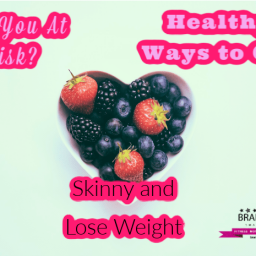Cardio is an extremely popular type of exercise, especially during the summer season.
Usually, doing more cardio is the first idea that people think of when they want to lose those last few pounds and get rid of stubborn belly fat.
However, what happens to most people after hours of cardio in the gym is that even if they lose some weight, they do not achieve the desired physique.
Why cardio is not very effective and what the science has to say about that, we will discuss in the following article.

The most effective method for weight-loss
The science is very conclusive – the most important factor for losing weight and stubborn belly fat (and fat from any other body area) is creating a caloric deficit – either by reducing caloric intake or increasing physical activity.
What the science says is that principles of energy and thermodynamics apply to our bodies just like they apply for everything else – if you spend more energy out than the energy you take in, there is no other option but to lose weight.
And while cardio is quite popular as physical activity, it is far from being the most effective way for several reasons, such as raising stress and cortisol, interfering with other types of training, increasing appetite and much more.
Take-Away:
The single condition to lose weight including stubborn fat areas is to consume fewer calories than you burn.
Effect of cardio on appetite
Every exercise causes stress, which forces the organism to adapt. This is usually good stress, as long as the organism can manage to adapt and recover.
However, the levels of cortisol, raised by that stress can lead to increased hunger during the post-workout compensatory meal.
There is significant evidence that compensatory eating after cardio might lead to cravings, probably because cardio also leads to higher cortisol raise, compared to other types of training (1).
Scientists have observed the caloric intake of women after low-intensity cardio training, during which 150 kcal were burned. There was a huge variation in the compensatory meal size among the women after that cardio session.
Half of the women overcompensated and consumed from 150 to 600 kcals more than what they normally consume, completely negating the effect from the exercise or even putting them in a caloric surplus – the main factor for gaining weight.
This means that if you feel increased hunger after a cardio session, it is better to avoid cardio altogether and simply slightly reduce your caloric intake.
Take-Away:
Cardio can potentially cause overcompensation in the post-training meal, resulting in overeating.
Fasted Cardio
There have been speculations that practicing cardio in the morning when in a fasted state, is the way to make it more effective especially in burning the belly fat.
One of the reasons for this myth is because experiments have shown that when performing it this way, it stimulates lipolysis.
The process of burning fat involves two stages – lipolysis, when the fats are released from mast cells into the bloodstream, and oxidation, when the actual use of fats for energy occurs.
However, studies show that in the case of fasted cardio despite the release of fats into the bloodstream, their oxidation and use for energy is not increased (2).
There was no benefit found when comparing fasted cardio to non-fasted one. Non-oxidized fats eventually go back into the mast cells.
Quite the opposite, fasted cardio might even be worse for a couple of reasons.
First of all, the energy levels in the morning and before breakfast are quite low for most people. This will make the cardio session much more stressful and unpleasant, ultimately resulting in lower capacity and effort for the workout.
Secondly, it increases the levels of cortisol which might lead to loss of muscle mass and increased hunger afterward. The result might be gaining fat instead of losing it.
Take-Away:
Fasted cardio is less effective and can lead to greater negative stress and muscle loss.
What about HIIT?
There is a lot of information out there about a different type of cardio, which is speculated to be a better option, as it resembles much more resistance training.
This is the high-intensity interval training method which is extremely popular nowadays.
It is speculated to be better because it burns the same amount of calories in less time, compared to moderate and low-intensity steady-state cardio.
There is also the so-called post-exercise effect, which means you keep burning an increased amount of calories even after the workout is completed – up to 7-8 hours.
However, a study showed that the post-exercise effect burned only 80 kcals extra for that long post-exercise period of elevated metabolism (3). And the comparison between high and moderate intensity, even when considering that effect, shows no significant differences.
Other studies showed that metabolic adaptations are quite similar for both types, while a recent systematic review of 13 studies concludes that high-intensity and medium-intensity both contribute to only modest improvements in body composition and reducing the body fat percentage (4) (5).
This means that the main advantage of high-intensity interval training compared to low-intensity steady-state cardio is the time it takes.
Even though high-intensity interval training saves time compared to classic cardio, there is another consideration to be taken in mind – since it is a much higher level of intensity and stress, it also requires longer to recover from.
This can lead to overtraining if there is a regular combination of high-intensity interval training and resistance training in a workout routine.
Take-Away:
While it can be a time-saver, high-intensity interval training is not more effective in comparison to low and medium intensity cardio.
Health benefits
Another reason why cardio is not very effective for fat-loss is that the body adapts quickly to regular aerobic training, which leads to the need for a constant increase in the cardio amount to see any weight-loss results.
A study involving runners showed that only the ones who progressively kept increasing the amount of cardio they did throughout their training, managed to maintain optimal body composition (6).
It is important to remember, however, that cardio like many other things is only beneficial for health in moderation.
Even though cardio might not be the best method to burn stubborn belly fat, a lot of people still consider it, because of health benefits for the hearth.
However, there is compelling evidence, suggesting that excessive amounts of exercise, either low or high intensity could lead to detrimental effects in the long term, which might outweigh the benefits (7).
Negative effects on cardiac health have been reported, ranging from myocardial fibrosis, coronary artery calcification, and diastolic dysfunction, to increased incidence of atrial fibrillation in veteran endurance athletes.
Another study also confirmed that intense endurance training might increase the risk of arrhythmogenic cardiac remodeling (8).
Take-Away:
Too much cardio might be more unfavorable than beneficial for cardiac health.
Cortisol
Too much chronic cardio training can also affect your hormones – particularly the stress hormone – cortisol.
Cortisol is a vital hormone for human life. Its normal functions include raising the blood sugar during stress, both by gluconeogenesis and glycogenolysis.
However, chronically increased levels will have negative effects – elevating the blood sugar chronically will cause the excess to be stored as fat, instead of back to glycogen.
This theory is confirmed by a few studies, one of which shows that more cardio does not lead to greater weight loss (9).
Another study showed that elevated levels of stress, combined with regular cardio training can lead to loss of muscle (10).
Endurance training has no effect of preserving muscle and a further increase in cortisol because of this type of training might even speed the muscle loss up.
Keeping the muscle mass is very important when dieting – it will help burn more calories because our muscle is very metabolically active tissue. Every muscle cell is a little calorie-burning engine – the bigger they are, the more they burn.
If we lose muscle, this makes the jo-jo effect of regaining weight much more likely, when the person stops dieting at some point.
Women are more susceptible to this because they start with lower muscle mass to begin with.
More on Cortisol
Cortisol levels can affect the balance between ghrelin and leptin – the hormones that regulate hunger.
Ghrelin is known as the hunger hormone because of its hunger-stimulating effect. It gets secreted from enterocytes when the stomach is empty, respectively gets suppressed right after a meal.
Leptin is the hormone that inhibits hunger. It is synthesized by enterocytes as well as fat cells. High amounts of body fat and high levels cortisol are another couple of factors that lead to increased synthesis of leptin.
Chronically elevated levels of leptin because of high body fat and cortisol, lead to resistance of the leptin receptors and the inability to suppress hunger, which might result in increased caloric intake.
Take-Away:
High amounts of cardio affect the levels of the stress hormone, which can lead to gaining fat when cortisol is chronically elevated.
Alternatives to cardio
The first and the simplest alternative is cutting the same amount of calories from the diet, instead of creating a deficit with long hours of cardio.
Multiple studies have shown that with or without cardio, the same caloric deficit leads to the same weight loss and similar changes in body composition (11) (12).
There are a few effective tips to do that, without having to count every calorie. For example:
- Intuitive eating – after a period of tracking calories and macros, a lot of people develop a sense for the approximate amount of ingredients in different foods;
- Protein in every meal – protein has a high thermogenic index, slows down digestion and helps build and preserve muscle mass – everything you need to keep yourself satiated during a diet;
- No liquid calories – they provide no satiation and can easily put you in a caloric surplus;
- Sugar and sweets only after a workout (after muscle glycogen has been depleted) or after dinner (carbohydrates at night help with sleep by boosting serotonin);
- Avoiding processed foods – those foods usually are high in fats and calories and you can very easily get into a caloric surplus;
- Avoiding some healthy, but caloric foods – foods like olive oil, nuts, honey;
- Avoiding snacks – especially with caloric foods like nuts or junk foods;
- Developing an eating schedule – when you get used to eating around a schedule, you will also feel hunger at the same time every day, making it much easier to plan your meals and avoid snacks or extra calories;
- Planning your meals – it makes it much easier to choose healthier options instead of processed foods.
Take-Away:
It is more efficient to maintain caloric balance by reducing caloric intake, instead of increasing expenditure with hours of cardio.
Resistance training
Another great alternative to adding cardio in your routine is resistance training.
Training with weights not only burns more calories but helps build muscle and provides much more variety, making it a more enjoyable workout.
A study shows that adding resistance training to the diet leads to better improvement of body composition (13).
A lot of women are worried that they might become too muscular or bulky because of weight training, but this is quite hard to achieve naturally.
While it is true that female skeletal muscles have the same potential for growth just like male ones, the low levels of testosterone in the female body make it a quite challenging and slow process, unless performance-enhancing drugs (steroids) come into play.
It is the building of muscle that gives fitness models their ‘toned’ look.
And while some might think that combining resistance training and cardio in the same workout session would be a good idea to burn even more calories, the science speaks otherwise.
According to multiple studies, when combining anaerobic (resistance) and aerobic (cardio) training, the positive effects of both are reduced (14).
It turns out that the metabolic pathways for adaptation to these two completely different stimuli are working in different directions (15).
For example, the enzymes activated in the organism after one of these stimuli blocks the other’s activity (16).
Protein kinase B is activated after training with weights and it helps build muscle by stimulating muscle protein synthesis and reduces the risk for muscle breakdown.
More on Resistance Training
On the other hand, when doing cardio 5′ adenosine monophosphate-activated protein kinase is getting activated, the role of which is to support fatty-acid uptake and oxidation, glucose uptake and glycolysis, all aimed to improve muscle endurance.
However, it inhibits protein synthesis and blocks the molecular signaling of Protein kinase B. This is why cardio might prevent progress in weight training not only for the leg muscles but for the whole body.
Cardio and resistance training benefit the development of different types of muscle cells (17).
While cardio benefits the hypertrophy of the slow-twitch muscle fibers – type 1, resistance training benefits fast-twitch muscle fibers – type 2.
Type 1 muscle fibers are more efficient over long periods of work. They have myoglobin which gives them their red color and allows them to use oxygen to burn glycose much more efficiently.
This is why we should prefer engaging more of the type 2 muscle fibers – they burn much more glycose, compared to type 1, because they cannot use oxygen and have much higher potential for hypertrophy.
That hypertrophy increases the basic metabolic rate – our daily caloric expenditure. It is the resistance training that forces type 2 muscle fibers into work and stimulates their development.
Take-Away:
Overall resistance training is better than cardio for losing stubborn belly fat, for both men and women, and both types of training should not be combined in the same workout session.
The bottom line on how losing stubborn belly fat
Overall cardio should not be the primary method for losing fat. When in excess, it can interfere with resistance training and recovery, lead to increased cortisol levels, increased appetite, loss of muscle mass and reduced metabolic rate, increased risk for regaining fat.
Variations like high-intensity interval training are not significantly more effective but much more likely to interfere with weight training.
Simply cutting the calories out of the diet, instead of trying to burn more with cardio is proven to be a more effective strategy.
To burn the stubborn belly fat and lose those last few pounds, evidence shows that the optimal way is by combining diet with weight training to preserve muscle and burn more calories.





